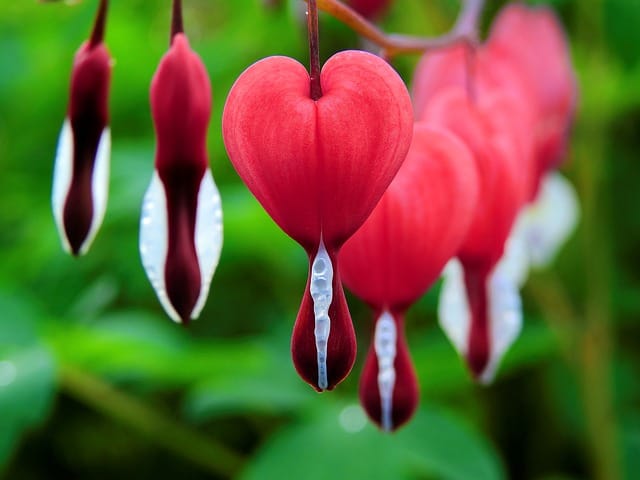How to grow Bleeding Hearts
The Bleeding Hearts flower, scientifically known as Dicentra, is a delicate perennial plant that produces unique heart-shaped flowers

In this article:
- Introduction and Overview
- Choosing the Right Location
- Soil Preparation and Requirements
- Propagation Methods
- Planting Bleeding Hearts
- Watering and Maintenance
- Providing Proper Support
- Dealing with Pests and Diseases
- Pruning and Deadheading
- Dividing and Transplanting
- Overwintering and Protection
- Common Varieties and Cultivars
- Companion Planting with Bleeding Hearts
- Landscaping Ideas and Design Tips
- Frequently Asked Questions
- Conclusion and Final Thoughts
Introduction and Overview
The Bleeding Hearts flower, scientifically known as Dicentra, is a delicate perennial plant that produces unique heart-shaped flowers. This article will guide you on how to successfully grow and care for this beautiful flower in your garden.
Choosing the Right Location
The Bleeding Hearts flower thrives in partial shade, making it ideal for planting in areas with high tree coverage or structures that provide filtered sunlight. Choose a location that receives morning sun and afternoon shade to ensure optimum growth.
Soil Preparation and Requirements
Bleeding Hearts prefer well-draining soil with a slightly acidic to neutral pH level. Prepare the soil by adding organic matter, such as compost or well-aged manure, to improve fertility and drainage. Avoid compacted or waterlogged soil, as it can lead to root rot.
Propagation Methods
Bleeding Hearts can be propagated through division or from seeds. Dividing established plants is the most common method, done during the early spring or fall. Seeds should be collected in late summer or purchased from a reputable nursery.
Planting Bleeding Hearts
When planting Bleeding Hearts, dig a hole that is wider and slightly deeper than the root ball. Place the plant in the hole and fill it with soil, ensuring the crown is level with or slightly above the soil surface. Water thoroughly after planting.
Watering and Maintenance
Keep the soil consistently moist but not overly saturated. Mulching around the base of the plant can help retain moisture, suppress weeds, and regulate soil temperature. Regularly remove any weeds to prevent competition for nutrients.
Providing Proper Support
Since Bleeding Hearts have delicate stems, providing support for taller varieties is essential to prevent bending or breaking. Use stakes or cages early in the growing season to provide guidance and maintain the plant's upright form.
Dealing with Pests and Diseases
Bleeding Hearts are generally resilient to pests and diseases. However, they may be susceptible to slugs, snails, and aphids. Regularly inspect the plants and take appropriate measures, such as handpicking or using organic insecticides, to control infestations.
Pruning and Deadheading
Prune Bleeding Hearts after flowering to maintain a tidy appearance and promote new growth. Remove any dead or damaged foliage and flowers. Deadheading, or removing faded flowers, can encourage prolonged blooming and prevent self-seeding.
Dividing and Transplanting
Bleeding Hearts benefit from division every three to five years to maintain plant health and vigor. Dig up the plant, carefully separate the root clusters, and replant them in their new locations, ensuring proper spacing and ideal soil conditions.
Overwintering and Protection
Apply a layer of mulch around the base of the plant to protect it from harsh winter temperatures. If you experience extremely cold winters, consider covering the plants with burlap or using a frost blanket for added protection.
Common Varieties and Cultivars
Some popular varieties of Bleeding Hearts include Dicentra spectabilis, Dicentra eximia, and Dicentra formosa. Each variety has its unique characteristics, such as flower color, size, and bloom time. Research and choose the variety that suits your garden best.
Companion Planting with Bleeding Hearts
Bleeding Hearts can be paired with other shade-loving plants to create an enchanting garden display. Consider planting them alongside hostas, ferns, astilbes, or other woodland perennials to enhance the overall beauty of your garden.
Landscaping Ideas and Design Tips
Bleeding Hearts add an elegant touch to shaded borders, woodland gardens, or along pathways. Use them as a backdrop for shorter plants or as a focal point in a container garden. Their unique drooping flowers create a romantic and whimsical atmosphere.
Frequently Asked Questions
Q: Can Bleeding Hearts tolerate full sun?
A: Although Bleeding Hearts prefer partial shade, certain varieties can tolerate a few hours of morning sun if provided with enough moisture.
Q: How long does it take for Bleeding Hearts to bloom?
A: Bleeding Hearts usually start blooming in late spring and continue to flower until early summer, though exact timing can vary depending on the variety and climate.
Q: Can I grow Bleeding Hearts in containers?
A: Yes, Bleeding Hearts can be grown in containers as long as you provide the right soil, moisture, and adequate drainage. Choose a larger container to accommodate their root system.
Conclusion and Final Thoughts
By following these guidelines and providing the right conditions, you can successfully grow and enjoy the beauty of Bleeding Hearts in your garden. Their delicate flowers, coupled with their low-maintenance nature, make them a must-have for any shade garden or woodland landscape. Experiment with different varieties, and have fun creating a stunning display with these captivating plants.
